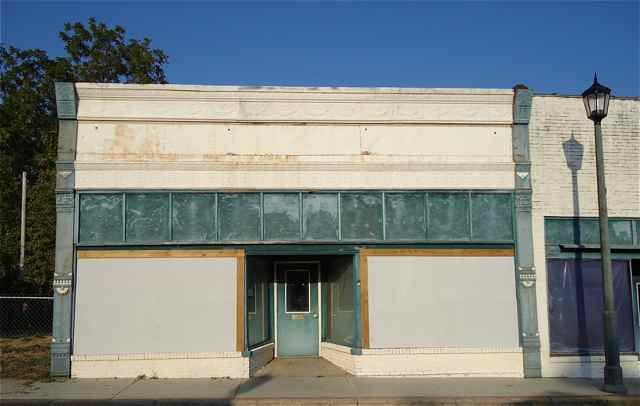
Cuba, MO's Mesker Building needs to be rescued and restored befitting its historical heritage.
The latest copy of Rural Missouri had an article by Jim Winnerman titled, “Small-town girl helps preserve historical stamped-metal facades.” Editor Jim McCarty graciously allowed us to print a link to the article. Initially, I stopped to read the article because I know the writer, and he has written Cuba-related topics before. This article was not about Cuba. Or I didn’t think it was.
The article is about 23 year-old Hallie Fieser who has a bachelor’s degree in historic preservation and has begun a master’s in public history. One of her areas of expertise is Mesker storefronts, manufactured in St. Louis and Evansville, Ind. by the Mesker Brothers Ironworks. They were erected between 1880 and 1920.
The article went on to say that they were popular in rural towns because the the storefronts could be ordered from a catalogue and shipped by railroad and could be installed quickly and cheaply to dress up the facade of a building without the expense of an architect or skilled craftsmen. As I was reading, I vaguely remembered Marilyn Stewart of Cuba’s Historic Preservation Commission mentioning that one of the buildings on Smith Street was a Mesker Building.
As I was going to the historic area on Smith Street to eat, I checked out the building that I thought might be a Mesker. Sure enough, the company’s signature nameplate was there as well as the other characteristics of a Mesker building.
Winnerman’s article mentioned these characteristics:
1. Cast-iron nameplates with the Mesker name stamped in.
2. Morning glory and fleu-de-lis repetitive patterns.
3. Cast-iron or pressed metal architectural elements including columns, cornice-bracket ornaments and window hoods.
4. Decorative sheet-metal panels with stone or brick designs.
5. A recessed entrance that provides increased window display space.
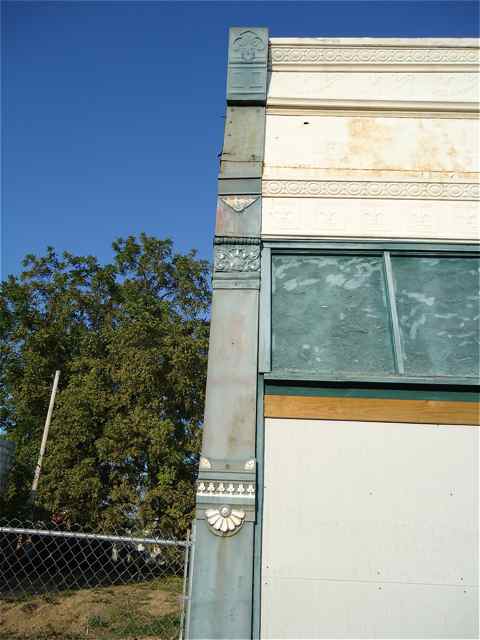
The fleu-de-lis at the top of the column is one of the Mesker storefront characteristics as is the pressed metal architectural elements across the top of the building.
I emailed Marilyn Stewart of Cuba’s Historic Preservation Commission about the history of the building. She said that the building had been the Bank of Cuba, Jake Dorf”s Hardware Store for a time, and a Bishops Clothing Store. She said that Gary and Ann Branson had a furniture store there, an American Sales Store, and the Head Start School had also been in the building. Recently, the builidng was condemned by the city, and the windows were boarded-up. Clearly, what might be an architectural legacy was not being treasured today. The boarded-up building on Smith Street has seen better days.
The subject of the article Hallie Fieser asked in the article that anyone knowing where a Mesker building was to email her, so I sent her the photos of our not-so-well-cared-for building. She replied, “Sadly the story of condemnation and poor repair is not uncommon with many Meskers across the state.”
Fieser provided me a couple of links for Mesker information. One initiative in Illinois tries to educate people about the significance of Meskers. If you go here, you can find photos and historical information about the buildings. She also wrote, “As far as good examples of restorations, there are many photos on the gotmesker? photostream on flickr:.” You can find those photos here. “Darius Bryjka updates the site and leads the Mesker efforts in Illinois. He is the one go-to man for me with any questions and has created a great collection of resources available online,” stated Fieser.
Fieser also said that she is working on a blog about Meskers and that she will send information when it is up and running.
It is pretty plain to see that Cuba’s Mesker needs a rescuer for its sad and neglected state. Much has been done in the Historic Uptown Cuba, but more remains to be done. We hope someone with vision and the resources to take on the project surfaces. In the meantime, check out some of the photos of restored Meskers on the flicker site. They are treasures.
See “Historic Cuba building gets a new look” for an example of historic preservation on Smith Street.
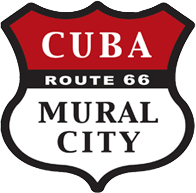




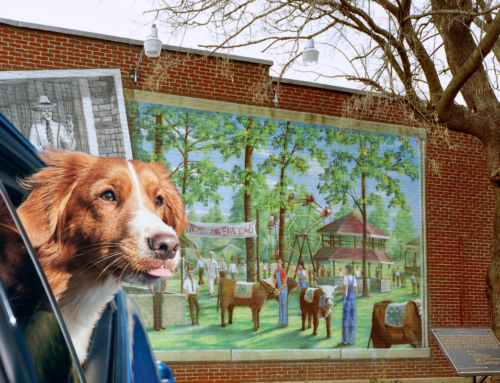

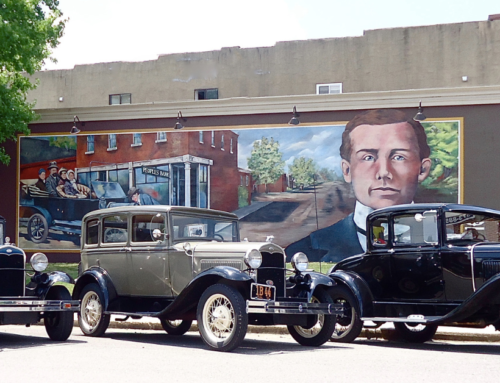

There were other buildings in Cuba with pressed brick pattern steel. Neither of the two I remember are still standing. Jake Dorf’s second hardware store was in the Methodist Church church prior to the church moving to the Wallace House property. I used to wonder what that building had looked like. The church window outlines could be seen in the metal that covered them. Oddly enough, the other building that was a two story one covered with the brick pattern was a hardware store also. James Hollow’s business sat where the current Peoples Bank parking lot is. The metal had rusted and the seams were popped in many places. Memory is a bit rusty too but I think that building was torn down in the early 1940’s.
I well remember all the businesses that used this building. It is such a shame that it was allowed to get in this condition.
Someone asked what buildings might have been there in the 70s. Do you remember?
I enjoyed reading this article as Hallie Fieser is my daughter. Did you talk with her any about the possibility of placing this building on the national register and possible tax credits for restoration? She may be able to fill you in on this as well. Does Cuba have a Main Street project for downtown development? Hallie may also be able to provide some resources for you to use in finding out more information about these projects.
Since the publication of her article in Rural Missouri, Hallie has graduated and moved on to a position as an architectural historian in Knoxville, TN.
If you wish to contact her again, you may do so at halliefieser@gmail.com
Good luck to you and your community in the restoration of this building.
Sincerely,
Mary Jane Fieser
Thank you for the updated information and comment. At this time, the building is owned by a private individual who has shown no interest in restoration. We hope that the situation might change in the future.
Recently, the building was purchased in a tax sale and the new owners will begin working on the building soon.
Great news! Thanks for the update! I love to hear success stories about Meskers! I was going to direct you to Darius’ Mesker Facebook page, but it looks like you found it!
Thanks again for sharing!
Hallie (Fieser) Hearnes
Very Nice little story. The pressed metal buildings along Frisco tracks have always seemed quite special to me. These buildings are everywhere in small towns in Colorado, and the railroad strip in Cuba makes me think of similar districts in places like Ouray and Colorado Springs.
Always liked the walk along those streets. Remember all the drug stores?
Small town drug stores were great. There were a wonderful place to meet friends.